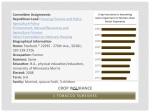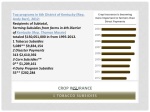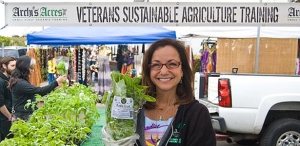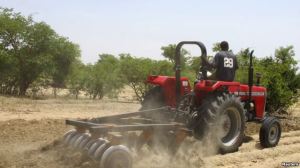“I voted for the bill because separating the two programs is a prerequisite to real reform, and represents a significant change in the way Washington does business” Further, the new Farm Bill still contains the Massie-Polis-Blumenauer Industrial Hemp Amendment the House passed two weeks ago. This amendment is a small but fundamental change in the laws that hopefully will one day allow Kentucky farmers to grow industrial hemp again.
Tobacco Subsidies NOT FOOD STAMPS! TAXPAYERS FORCED TO PAY THE TOBACCO CO. TOBACCO HAVE NEEDS TOO. Phillip Morris USA comes to Danville, KY
Kentucky State University
Overall % Graduation
27% 47% Graduation Rate
27%
PRESS RELEASE: U.S. Representative Massie Votes in Favor of Agriculture Reform
The farm bill I voted against two weeks ago was a food stamp bill masquerading as a farm bill, with 80% of the funding going to food stamps. It contained only meager welfare reforms barely slowing the exponential growth of that entitlement program.
As a conservative, I’m glad to see direct payments eliminated in this new farm bill. As a cattle farmer I understand firsthand the importance of agricultural policy reform. While there are still issues with this bill, it is important to recognize that removing the food stamp portion of it is a key first step in a larger process. It is also important to recognize that decoupling food stamps from the rest of the bill gives us the opportunity to debate nearly $400 billion as a standalone item. As a matter of open and transparent government, our constituents deserve to have these two issues debated separately.
What are the different sections or titles of the Farm Bill?
- Representative Paul Anderson (R) District: 12B
The most recent Farm Bill proposals contain twelve titles, including the following:
- Commodity: crop-specific subsidies for specified crops such as grain, oilseeds, cotton, and rice (through direct, counter-cyclical, marketing loan, and shallow loss payments) and other industry-specific programs for milk and sugar
- Conservation: conservation standards and payments for land stewardship and other conservation practices
- Trade: agricultural export and international food assistance programs
- Nutrition: domestic nutrition assistance programs like food stamps, emergency assistance, and healthy food initiatives
- Credit: subsidized direct loans and loan guarantees for agricultural producers
- Rural development: programs to boost rural economic development and subsidize rural housing, utilities, and broadband internet
- Research: spending on agricultural, food safety, and biotech research and extension programs
- Forestry: programs for forest protection, stewardship, and restoration
- Energy: subsidies for corn ethanol and next-generation biofuels, other forms of renewable energy, and energy efficiency initiatives
- Horticulture: programs for organic agriculture and specialty crops (like fruits, vegetables, and nuts)
- Crop Insurance: insurance premium subsidies for crop and livestock producers and administrative and operating subsidies for crop insurance companies, among others
- Miscellaneous: provisions related to socially disadvantaged farmers, livestock programs, and other miscellaneous topics
6th District Of Kentucky (Rep. Andy Barr) Summary Information$251 million in subsidies 1995-2012.
$168 million in commodity subsidies.
$24.8 million in conservation subsidies.
$57.7 million in disaster subsidies.
65 percent of farms in Kentucky did not collect subsidy payments – according to USDA.
Ten percent collected 73 percent of all subsidies.
Amounting to $182 million over 18 years.
Top 10%: $4,347 average per year between 1995 and 2012.
Bottom 80%: $97 average per year between 1995 and 2012.
65 percent of farms in Kentucky did not collect subsidy payments – according to USDA.
- Representative Paul Anderson (R) District: 12B
Ten percent collected 73 percent of all subsidies. Number of Recipients Subsidy Total 2012 (DOES NOT INCLUDE COST PAID For INSurance
During the food stamp debate, #GOP #RepStephenFincher, who received thousands in farm subsidies, responded to a Democratic Congressman during the debate over the cuts by quoting the bible, saying “the one who is unwilling to work shall not eat.”
Fincher himself has received his own large share of government money. From 1999 to 2012, Stephen & Lynn Fincher Farms received $3,483,824 in agriculture subsidies. Last year he took in $70,574 alone.
|
Ten-Year Costs of Federal Farm Bills, in Billions of Dollars |
|||
|
2002 |
2008 |
2012 |
|
| Projected cost after bill was passed |
$451 |
$604.1 |
$950-963* |
| Actual cost |
$587.5 |
$916.6** |
|
| Percent each bill is over budget |
30% |
52% |
|
| Percent increase from previous bill (projected costs compared) |
34% |
57 – 59% |
|
| Notes: * Final bill has not been signed into law, but respective versions have passed the full Senate and House Agriculture Committee.** Includes actual costs for FY08-11 and estimated costs for FY12-17. | |||
Related articles
- Meet Your Taxpayer-Subsidized Farm Bill Billionaires! (huffingtonpost.com)
- Billionaires Reap $11 Million in Farm Subsidies (bighealthreport.com)
- Millions in farm subsidies doled out to billionaires between 1995-2012 (engineeringevil.com)
- Massie To Draw A Challenge? (bluegrassbulletin.com)
- Outrage Over Farm Subsidies Misses the Point (organicagjournal.com)
- Billionaires Get $11.3M in Farm Welfare (drudge.com)
- These Republicans Who Voted To Cut Food Stamps Personally Received Large Farm Subsidies (buzzfeed.com)
- Fat Cats and Food Stamps (swampland.time.com)
- U.S. Congress has about 50/50 chance of passing farm bill in 2013 -analyst (uk.reuters.com)
- Six facts you need to know about the Farm Bill (voxxi.com)


























